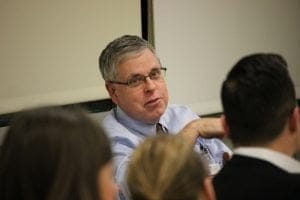
With more than 400,000 Americans dying each year from preventable medical errors, University of Chicago Medicine leadership taught a fall translational science course addressing quality improvement and patient safety. The six-week training put participants at the forefront of patient safety with dynamic, honest discussions about how to apply the science of improvement to their work.
“People’s lives can be saved if we can do better in this area,” said Laura Botwinick, Director of the Graduate Program in Health Administration and Policy (GPHAP) and one of the course instructors. “What we’re doing is bringing that theory and science to the class and asking students to apply it to real projects, in our medical center, in each of their departments.”
About 30 students attended Quality Improvement and Patient Safety 101, one of several quarterly course offerings from the Committee on Clinical and Translational Science (CCTS), a freestanding UChicago academic unit supported by the Institute for Translational Medicine (ITM) and The Center for Health and the Social Sciences (CHeSS). The free class is the first in a series leading to a Quality Improvement and Patient Safety Certificate, and participants also had the option of enrolling through the Registrar to receive course credit.
“Healthcare professionals learn the clinical aspects of their field, but few have received formal training on quality improvement,” said Botwinick. “They become very good scientists and caregivers, but they aren’t taught how to improve the systems within which they work. This course is filling that need.”
It’s a need that is especially important when it comes to translational science, said Andrew Davis, MD, Associate Professor of Medicine and one of the class instructors. Davis said it’s one thing to make a discovery during a clinical trial, and it’s another to translate it to your local setting.
“It’s an enormous gap,” Davis said. “Having knowledge and awareness of evidence-based findings is of little use to providers if that evidence is not consistently implemented into their systems and processes. Quality improvement training can give them the skills and tools to help close that gap.”
The fall class covered everything from the science of improvement to communication and teamwork to methods and measurements, and UChicago quality improvement experts Thomas J. Best, Samira Qadir, and Samantha Ruokis held office hours to help students identify and design their group projects.
Jose Enes, Manager of Interventional Radiology, came up with the idea his group eventually tackled: decreasing patient wait times.
“Our goal is to make sure that our patients are happy,” said Enes, who has prior process improvement leadership training. “They say we’re late. To sit and allow thestatus quo and things to circle around you and not be a part of the change – it means your demise.”
When interventional radiology does not meet a target 8:00 a.m. start time, he said they found it tacked on 30 minutes to every time slot that its patients were scheduled. By noon, patients could be waiting more than an hour for their appointments.
And when the patients’ referring doctors do not have certain lab work done prior to the appointment, the department needs to draw and read the tests before the patient can be seen. Satisfying that Society of Interventional Radiology requirement alone can add up to two hours onto patients’ wait times.
“The patient has not even walked in the door and we are already late,” Enes said. “We’re working on that now, identifying all of our patients who don’t have labs at the time they are being scheduled.”
His group looked at the problems from a time value standpoint and came up with ideas for improved scheduling methods.
For example, interventional radiology will soon be using a different scheduling platform that takes into account the prep, procedure, and turnover times for each individual patient. That way when a patient is booked for a two-hour procedure starting at 8:00 a.m., the next available appointment will be after 10 a.m.
Enes said it was great to be surrounded by faculty and staff from a variety of disciplines to open his eyes to factors he might have otherwise missed. For example, one of his teammates asked him why schedulers told patients to arrive an hour before their appointments when it only took about 45 minutes to prep them.
“If you look at the same thing every day, you start to overlook things,” Enes said. “When someone new comes in, they’re going to see something completely different, and you may find a new solution or problem you didn’t even think was there.”
He said at the end of the day reducing the wait times will improve both the quality of care and patient safety.
“Our patients will be given the appropriate time that they need and it will reduce our overtime, which will also help our employees’ work-life balance,” Enes said. “We know that fatigued workers are not happy to be there, and that can sometimes impact their overall view on patient care.”
Enes said the group project was translational science at its best – using the scientific method in a process improvement state – and that it would live on after the class drew to a close.
“Quality improvement can be hard for some people because it can point out things that you didn’t want to be shown,” Enes said. “But it’s honest, and in solving problems honesty is the only way to successfully address what you set out to fix.”
The members of Enes’ team included: Amy Helmer, Liz Nguyen, Stefanie Manack, and Maxine Washington.



